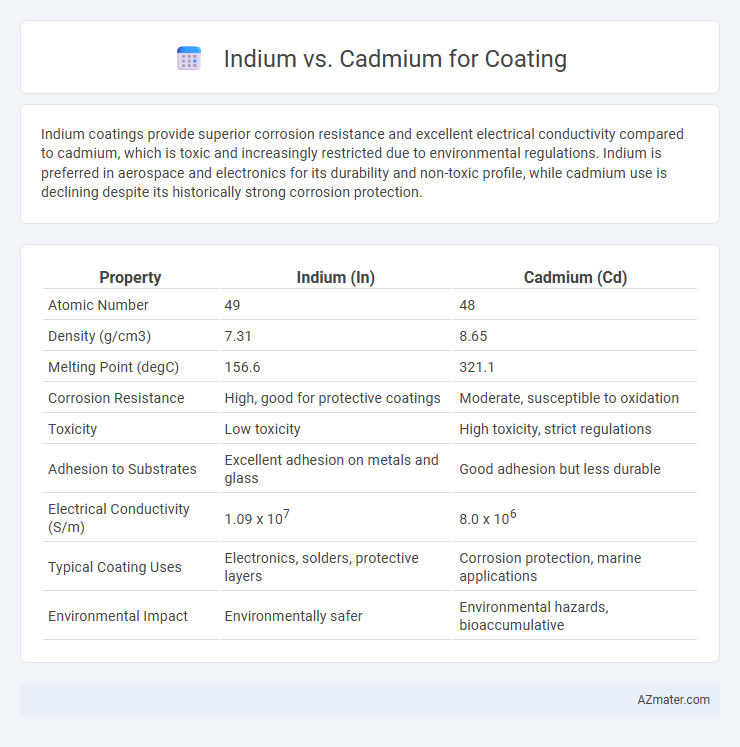Indium coatings provide superior corrosion resistance and excellent electrical conductivity compared to cadmium, which is toxic and increasingly restricted due to environmental regulations. Indium is preferred in aerospace and electronics for its durability and non-toxic profile, while cadmium use is declining despite its historically strong corrosion protection.
Table of Comparison
| Property | Indium (In) | Cadmium (Cd) |
|---|---|---|
| Atomic Number | 49 | 48 |
| Density (g/cm3) | 7.31 | 8.65 |
| Melting Point (degC) | 156.6 | 321.1 |
| Corrosion Resistance | High, good for protective coatings | Moderate, susceptible to oxidation |
| Toxicity | Low toxicity | High toxicity, strict regulations |
| Adhesion to Substrates | Excellent adhesion on metals and glass | Good adhesion but less durable |
| Electrical Conductivity (S/m) | 1.09 x 107 | 8.0 x 106 |
| Typical Coating Uses | Electronics, solders, protective layers | Corrosion protection, marine applications |
| Environmental Impact | Environmentally safer | Environmental hazards, bioaccumulative |
Introduction to Indium and Cadmium Coatings
Indium and cadmium coatings are widely utilized in industrial applications due to their distinct protective properties. Indium coatings offer excellent corrosion resistance and enhanced solderability, making them ideal for electronic components and aerospace parts. Cadmium coatings provide superior corrosion protection in marine and military environments but face environmental and health restrictions due to cadmium's toxicity.
Chemical Properties and Composition
Indium and cadmium exhibit distinct chemical properties influencing their suitability for coatings; indium is a soft, malleable post-transition metal with a melting point of 156.6degC and excellent resistance to oxidation, forming stable oxide layers that protect surfaces. Cadmium, a toxic heavy metal with a melting point of 321.1degC, offers superior corrosion resistance and is often alloyed to enhance mechanical durability but poses environmental and health risks due to its toxicity and bioaccumulation. The elemental composition and chemical stability of indium favor applications requiring non-toxic, low-temperature coatings, while cadmium's robustness suits industrial environments demanding high corrosion protection.
Corrosion Resistance Comparison
Indium coatings exhibit superior corrosion resistance compared to cadmium, especially in marine and highly saline environments, due to their stable oxide layer that protects against oxidation and pitting. Cadmium coatings provide effective corrosion protection but tend to degrade faster under prolonged exposure to acidic or alkaline conditions, leading to potential environmental and health concerns from cadmium toxicity. Indium's non-toxic nature combined with enhanced resistance to galvanic corrosion makes it a preferred choice for sustainable and long-lasting protective coatings in critical industrial applications.
Electrical Conductivity Performance
Indium exhibits superior electrical conductivity compared to cadmium when used as a coating material, making it ideal for applications requiring efficient current flow, such as in electronics and connectors. Cadmium coatings offer corrosion resistance but have lower conductivity, limiting their effectiveness in high-performance electrical components. Selecting indium enhances signal integrity and reduces energy loss, crucial for advanced electrical and electronic systems.
Durability and Mechanical Strength
Indium coatings offer superior corrosion resistance and flexibility, making them ideal for applications requiring moderate mechanical strength with excellent durability under thermal cycling. Cadmium coatings provide exceptional hardness and wear resistance, delivering higher mechanical strength but lower environmental durability due to toxicity and susceptibility to corrosion in acidic conditions. Choosing between indium and cadmium coatings depends on balancing the need for mechanical robustness with environmental and longevity considerations in specific industrial applications.
Application Methods and Techniques
Indium and cadmium coatings are applied using distinct methods suited to their material properties and intended applications. Indium coatings often utilize electroplating and thermal spraying techniques, providing excellent corrosion resistance and electrical conductivity vital for electronics and aerospace components. Cadmium coatings are primarily deposited through electroplating and mechanical plating, delivering superior corrosion resistance in marine and aerospace industries, especially for steel parts requiring sacrificial protection.
Environmental and Health Considerations
Indium coatings offer a safer alternative to cadmium due to their lower toxicity and reduced environmental impact, making them preferable in applications with stringent health regulations. Cadmium, classified as a carcinogen by the EPA and subject to strict disposal controls, poses significant risks including heavy metal contamination and bioaccumulation in ecosystems. The shift towards indium-based coatings supports sustainability efforts by minimizing hazardous waste and occupational exposure, aligning with global environmental safety standards.
Industry-Specific Uses and Preferences
Indium coatings are favored in the electronics industry due to their excellent electrical conductivity, corrosion resistance, and softness, which enable superior solderability for delicate components. Cadmium coatings are commonly used in aerospace and marine applications because of their exceptional corrosion resistance and lubrication properties, protecting metal parts from harsh environments. Industry preference leans towards indium for precision electronics, while cadmium remains preferred for heavy-duty corrosion protection despite environmental and health concerns prompting regulatory restrictions.
Cost and Availability Analysis
Indium coatings generally exhibit higher costs due to limited global reserves and complex extraction processes compared to cadmium, which is more abundant and economically accessible. Cadmium's widespread availability leads to lower market prices, making it a cost-effective choice for industrial applications requiring corrosion resistance. However, regulatory restrictions on cadmium use due to toxicity may impact its availability and long-term cost stability in certain markets.
Choosing the Right Coating: Indium or Cadmium?
Indium coatings offer superior corrosion resistance and non-toxicity, making them ideal for sensitive electronic components and aerospace applications. Cadmium coatings provide excellent protection against saltwater corrosion and deliver good electrical conductivity, favored in military and marine environments. Selecting between indium and cadmium depends on application-specific requirements such as environmental exposure, regulatory constraints, and desired durability.

Infographic: Indium vs Cadmium for Coating
 azmater.com
azmater.com